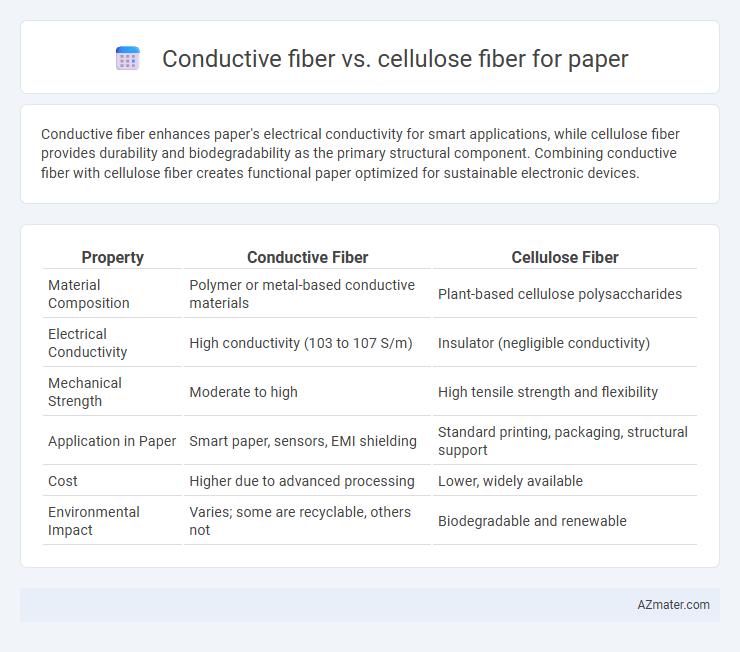Conductive fiber enhances paper's electrical conductivity for smart applications, while cellulose fiber provides durability and biodegradability as the primary structural component. Combining conductive fiber with cellulose fiber creates functional paper optimized for sustainable electronic devices.
Table of Comparison
| Property | Conductive Fiber | Cellulose Fiber |
|---|---|---|
| Material Composition | Polymer or metal-based conductive materials | Plant-based cellulose polysaccharides |
| Electrical Conductivity | High conductivity (103 to 107 S/m) | Insulator (negligible conductivity) |
| Mechanical Strength | Moderate to high | High tensile strength and flexibility |
| Application in Paper | Smart paper, sensors, EMI shielding | Standard printing, packaging, structural support |
| Cost | Higher due to advanced processing | Lower, widely available |
| Environmental Impact | Varies; some are recyclable, others not | Biodegradable and renewable |
Overview of Conductive Fiber and Cellulose Fiber
Conductive fibers, typically made from materials such as carbon, metal-coated polymers, or intrinsically conductive polymers, enable electrical conductivity and are used in smart paper and electronic applications. Cellulose fibers, derived from plant sources like wood pulp, are the primary components of traditional paper, offering biodegradability, mechanical strength, and excellent printability. The key difference lies in conductive fibers providing functionality for electronic integration, while cellulose fibers ensure structural integrity and environmental sustainability in paper products.
Material Composition and Structure
Conductive fibers for paper are typically composed of carbon-based materials, metal-coated polymers, or intrinsically conductive polymers such as polyaniline, offering high electrical conductivity and flexibility due to their nanoscale fibrous structure. Cellulose fibers, derived from plant sources like wood pulp, consist primarily of long chains of glucose units forming a fibrous network with high tensile strength, biodegradability, and moisture absorption. The structural differences between conductive and cellulose fibers affect paper functionality, with conductive fibers enabling electrical pathways while cellulose fibers provide mechanical support and porosity.
Electrical Properties Comparison
Conductive fiber exhibits significantly lower electrical resistivity compared to cellulose fiber, enabling efficient electron flow in paper applications requiring conductivity. Cellulose fiber, being an insulator with high resistivity, lacks the capability to support electrical current, making it unsuitable for electronic or sensing paper. The integration of conductive fibers such as carbon or metal-coated fibers enhances paper's electrical properties, offering improved conductivity, responsiveness, and potential for flexible electronic devices.
Mechanical Strength and Flexibility
Conductive fibers in paper enhance mechanical strength by improving tensile and tear resistance through integrated conductive materials, while cellulose fibers provide natural flexibility and structural integrity due to their fibrous network. Cellulose fibers contribute to paper durability with high strain-to-failure properties, ensuring flexibility without compromising strength. The combination or selection depends on the application's emphasis on electrical conductivity alongside mechanical performance.
Manufacturing Processes
Conductive fibers for paper manufacturing often involve coating or embedding materials like carbon, metal, or conductive polymers through processes such as electrospinning or chemical vapor deposition, requiring specialized equipment and controlled conditions. In contrast, cellulose fibers are derived from wood pulp using mechanical or chemical pulping methods, followed by refining and bleaching to enhance fiber properties, representing a more traditional and widely established process. The integration of conductive fibers typically demands additional steps for uniform dispersion and connectivity within the paper matrix, influencing both production complexity and cost.
Applications in Modern Paper Products
Conductive fibers enhance modern paper products by enabling applications in smart packaging, flexible electronics, and sensors due to their ability to transmit electric signals. Cellulose fibers, derived from plant sources, remain essential for traditional paper strength, biodegradability, and printability in products like packaging, tissue, and specialty papers. Combining conductive fibers with cellulose fibers expands the functionality of paper products, integrating sustainability with advanced electronic features.
Environmental Impact and Sustainability
Conductive fibers often derive from synthetic materials, posing challenges in biodegradability and recycling compared to cellulose fibers, which are naturally sourced from wood pulp and exhibit higher biodegradability, supporting closed-loop recycling. Cellulose fibers contribute to carbon sequestration and generally require less energy-intensive processing, reducing their overall environmental footprint relative to conductive fibers. Innovations in conductive fiber production aim to improve sustainability, yet cellulose fibers remain a benchmark for eco-friendly paper manufacturing due to their renewable origin and lower ecological impact.
Cost Efficiency and Scalability
Conductive fibers generally incur higher production costs due to specialized materials like carbon or metal coatings, affecting the overall cost efficiency compared to cellulose fibers, which are abundant and inexpensive. Scalability of cellulose fiber-based paper is well-established with existing large-scale manufacturing infrastructure, whereas conductive fiber integration requires advanced processing techniques, limiting rapid scale-up. Cost efficiency favors cellulose fibers in mass production, while conductive fibers, despite higher costs, enable multifunctional applications that may justify investment in niche markets.
Performance in Specialized Paper Uses
Conductive fiber enhances the electrical conductivity and durability of specialized paper, making it ideal for applications such as flexible electronics and smart packaging. Cellulose fiber offers excellent mechanical strength, biodegradability, and printability, crucial for traditional and eco-friendly paper products. While conductive fibers improve functionality through integrated circuits and sensors, cellulose fibers excel in sustainability and structural integrity for specialized paper uses.
Future Trends and Innovations
Innovations in conductive fiber for paper emphasize integrating nanomaterials like graphene and carbon nanotubes to enhance electrical conductivity without sacrificing flexibility. Cellulose fiber research focuses on bioengineering and chemical modifications to improve strength, biodegradability, and sustainability for next-generation paper products. Future trends highlight hybrid materials combining conductive and cellulose fibers to create multifunctional, eco-friendly papers for smart packaging and flexible electronics.

Infographic: Conductive fiber vs Cellulose fiber for Paper
 azmater.com
azmater.com